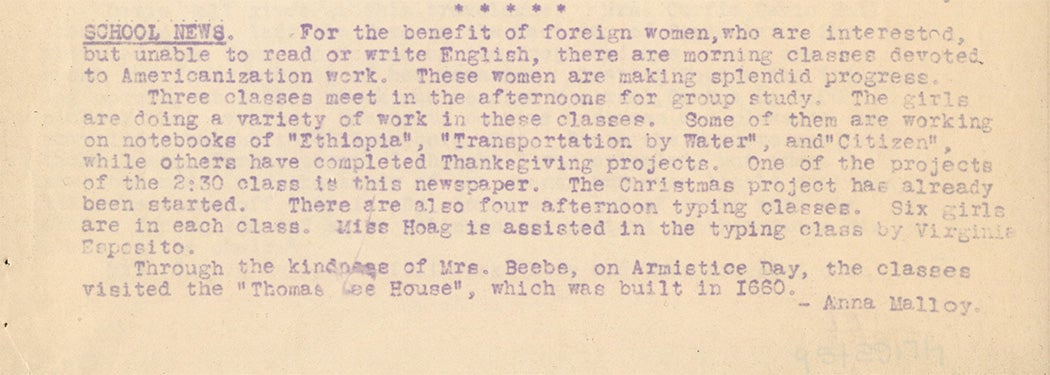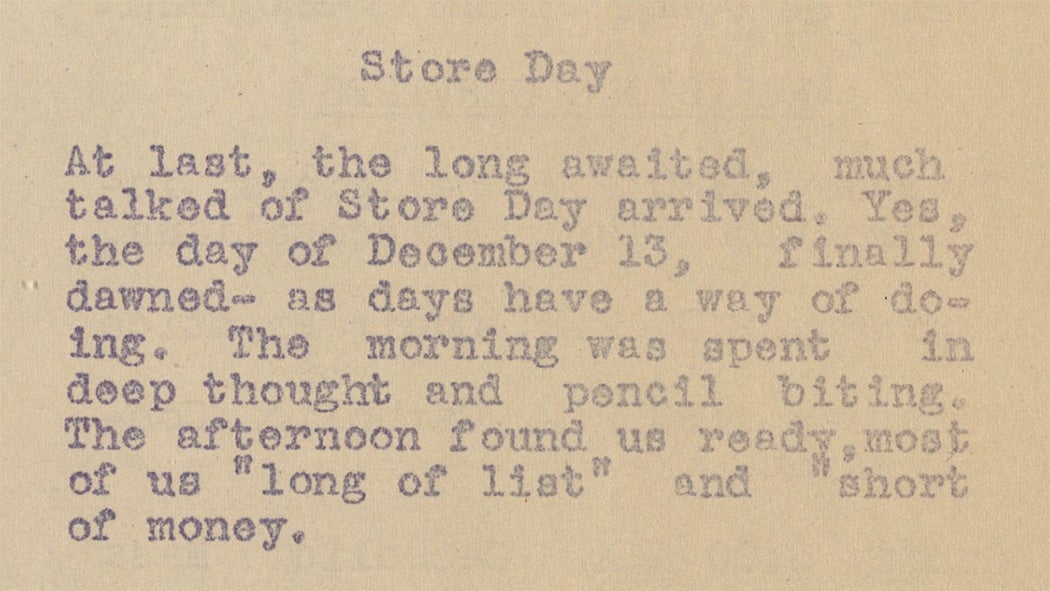The Connecticut State Farm for Women was a triumph of progressive reform when it opened its doors to twelve prisoners in 1918. Built on an old farm in Niantic, a coastal village in Connecticut, this early correctional facility made exclusively for women consisted of a few scattered cottages, a vegetable garden, and a dairy farm. “Duties are many and varied,” a woman named Ethel Cooper wrote in 1935, describing a typical day on the farm, “from planting tulip bulbs and roses in our garden to teaching a calf to drink.”
But three surviving issues of the Farm’s internal newsletter—called, evocatively, The Hour Glass—reveal familiar truths about how incarceration, in any guise, distorts a prisoner’s sense of time in ways that run counter to its intended purpose.
The first issue of The Hour Glass was published in November 1935. It’s prefaced with the descriptions of several time-keeping devices, among them a water clock called a clepsydra. Similar to an hourglass, a clepsydra measures time through the transfer of water from one vessel to another. The devices were used in Roman courts, through which they entered common parlance. “To lose water” meant to waste one’s time; meanwhile, the Greeks called the clepsydra, literally, “water-thief.”
One scholar, writing about the clepsydra and other early time-keeping devices, emphasized the quandary of measuring time, a concept without physical substance. One cannot simply “take a little ‘chunk of time’” and put it against a measuring stick, they write. Instead, as illustrated by the clepsydra, “we are forced to have recourse to the measurement of something else.”
The writers of The Hour Glass seem acutely aware of this contradiction in measuring time. In their introduction, they observe that while “the same sands” run through an hourglass, the hours they represent pass “forever.” The writers are referring to the year’s end, and, as they “tear off the last pages of the 1935 calendar,” their outlook is unusual. They don’t express hope for the new year, but rather focus on lamenting time lost, “as we look back over the twelve months and feel how little has been accomplished.”

One could argue that this is a form of apology, repentance for having slipped “down into the easy, dangerous ways which lead to disaster.”
Indeed, we expect remorse from those we imprison. The social scientist and criminologist J. C. Oleson once proposed an intentionally absurd thought experiment: what if instead of incarcerating people, we put them in a “punitive coma” for the duration of their sentence? Prisoners would simply wake to find themselves older, their time, or rather their punishment, having been painlessly extracted. Oleson’s Swiftian proposal reveals what we really want from punishment: not the time itself, but the prisoner’s awareness of its loss.
Still, one could argue that the outlook of the writers in The Hour Glass is not entirely borne from remorse, but also frustration over their inability, lacking that crucial “something else,” to measure time.
The Farm was constructed during the early-twentieth-century women’s reformatory movement in Connecticut. A coalition of suffragists and public health activists—alongside the conservative women’s group, Daughters of the American Revolution—argued that women who commit crimes should not be housed in prisons with men, even if the populations were held separately. According to scholar Joanne Belknap, the coalition’s arguments, however benign in appearance, were rooted in sexism. Unlike men, women were incarcerated for offenses like adultery, prostitution and “public lewdness.” Reformers were not interested in challenging the validity of these crimes. Instead, they sought to create prisons that would teach women how to appropriately enact their gender.
The Farm was designed, Belknap writes, to be “homey,” the atmosphere built to encourage those incarcerated to be “good wives and maids.” (The Farm was indicative of many women’s reformatories of the time; Bedford Hills Correctional Facility in upstate New York was once known as the Westfield State Farm. Visitors can still see remnants of the old architecture outside of what is now a maximum-security prison.) To this end, women not only ran a working farm, but a laundry and a hospital nursery, first erected because a number of those incarcerated were pregnant or new mothers. Women also learned to cook and sew, and those who could not speak English took classes in something called “Americanization.”

On the surface, the lives of the people who were incarcerated at the Farm may seem full and varied, even edifying by the sexist, racist standards of the day, but the writers of The Hourglass seem hesitant to describe it this way. Readers may learn that in 1935, thirty women hand-washed laundry (“lingerie, sweaters, rag rugs, woolen blankets”) for more than 300 people, including officers and locals, or that the Farm canned some 14,000 quarts of fruit and vegetables the same year—but what did their days look like? And how did they feel about them? The writers seem ambivalent about this information, even though many of the headlines suggest that they were encouraged to describe what they did, made, and learned. “Some [girls] have never been taught to sew so are taught there,” Dorothy Bonney reports of the Elementary Sewing Class. Or take poor Alice Coleman. As part of a larger article called “This Work-A-Day World,” Coleman, grasping for a shred of enthusiasm for a required daily activity, writes, “Well folks, here comes the big news all about the cooking school.”
The writers of The Hour Glass were more interested in writing about moments that deviated from their rigorously controlled routine. Their detailed documentation of holidays, for instance, offers some tantalizing insight into their experiences. In a rigid entry titled, “My First Thanksgiving Away From Home,” an author called “A New Girl” gives thanks that the meal was not as bad as she thought it was going to be. Meanwhile, an entry about a Memorial Day celebration notes that the “girls who had babies buried in the Niantic cemetery took flowers and decorated the graves.”
The writers record the wisdom of invited speakers (“Don’t serve time, make time serve you!” advises the notably not-incarcerated guest speaker at the prison, Austin H. MacCormick) and breathlessly recount each Store Day, bringing farmer’s market blogger energy to a 1930s prison commissary. “[A]fter much waiting and hoping, we were to have Store Day,” Thelma Sparrow and Ethel Cooper tell us. Of course, it would be “bedlam” to have everyone shopping at once, they write. A schedule is made but does little to quell the excitement caused by the “main attraction”: needlework, embroidery, and thread. When the day is done, the girls are wistful. “[E]veryone went home with a feeling of elation and the hopes that another Store Day would not be very far away.”
This pseudo-enthusiasm is eerily unchanged five years later, when Catherine C. writes: “At last, the long awaited, much talked of Store Day arrived… The morning was spent in deep thought and pencil biting. The afternoon found us… ‘long of list’ and ‘short of money.’” Woe to the poor new girl, who waltzed into Store Day thinking all the goods were free—her embarrassment outlives her, recorded in the pages of The Hour Glass.

But these recollections, both funny and bleak, are punctuated with cryptic quotations about time, like this one from the nineteenth-century theologian and philosopher, James Martineau, who wrote, “The mere lapse of years is not life.”
Difference and change, St. Augustine argues, are the makings of a life. We measure time in memory, he writes, or more specifically, the “impress produced… by things as they pass… not… the things themselves.” Law professor Linda Ross Meyer uses this quote in the first chapter of her book, Sentencing in Time, to explain how prisoners are “externalized” from time. In other words, the women on the Farm likely saw themselves as existing outside of time as it’s experienced by those who are free, thus their outsized interest in those moments of fleeting contact with it. In a brief essay called, “Preparedness,” Ethel E. urges her fellow prisoners “inside” to mentally ready themselves for freedom, using the words “future” and “outside” interchangeably.
The Hour Glass illustrates, subtly, chillingly, that even the most well-intentioned reforms cannot reconcile the central contradiction of incarceration. Those on the outside view “doing time” as active, a quantity of something generated and given to repay a social “debt.” This penal logic, derived from the rule of jus talionis, or “an eye for an eye,” views “offense and retribution,” the Marxist scholar Evgeny Pashukanis explains, as an “exchange.” But this neat jurisprudence ignores the fact that time is not a quantifiable thing that can be generated, much less given. As Meyer observes, “doing time” for those in prison is simply a period to be endured until one is allowed to rejoin time again.
Weekly Newsletter
“Meaningful human life experience,” Meyer writes, requires narrative and storytelling, active “planning toward a future, and reinterpreting a past.” In other words, how can one reflect and grow if one cannot actively engage in time? The reformers who built the Farm had hoped to create meaningful life experiences for their prisoners, but these rehabilitative efforts, even when they brought some pleasure or pride, were experienced as their own form of control—and over the years, control has emerged as its central aspect.
The remaining issues of The Hour Glass appear to readers nearly 100 years later as relics. The first issue includes simple hand drawings and typeset fading into yellowed paper. The third issue, from 1940, looks more professional. It also notes that the newsletter’s readership had grown to include prisoners in other facilities in other states, suggesting that the women of the Farm saw their true community among other incarcerated people, not, as was intended, among the people of Niantic. The Farm’s population, in those scant five years, grew as well, fueling (or perhaps, fueled by) rapid expansion paid for with an outpouring of federal funds. In 1940, MacCormick, the aforementioned guest speaker, praised the Farm, as it was still then called, as a “model” reformatory, noting with appreciation that the old wooden cottages had been replaced with “modern fire-proof buildings.” At some point, the farm itself was closed. The facility was renamed the Niantic Correctional Institution, and in 1994, became the Janet S. York Correctional Institution. The state’s only women’s prison, York is built to house as many as 1,500 women.
The feelings expressed by the writers of The Hourglass might resonate with the prisoners at York. Left to watch the clock, an unnamed editor wrote, “the best we can do is try to measure our growth by the feeling of strength we have to face the new year.”
Editor’s Note: This article was edited to add missing punctuation.
Support JSTOR Daily! Join our new membership program on Patreon today.







